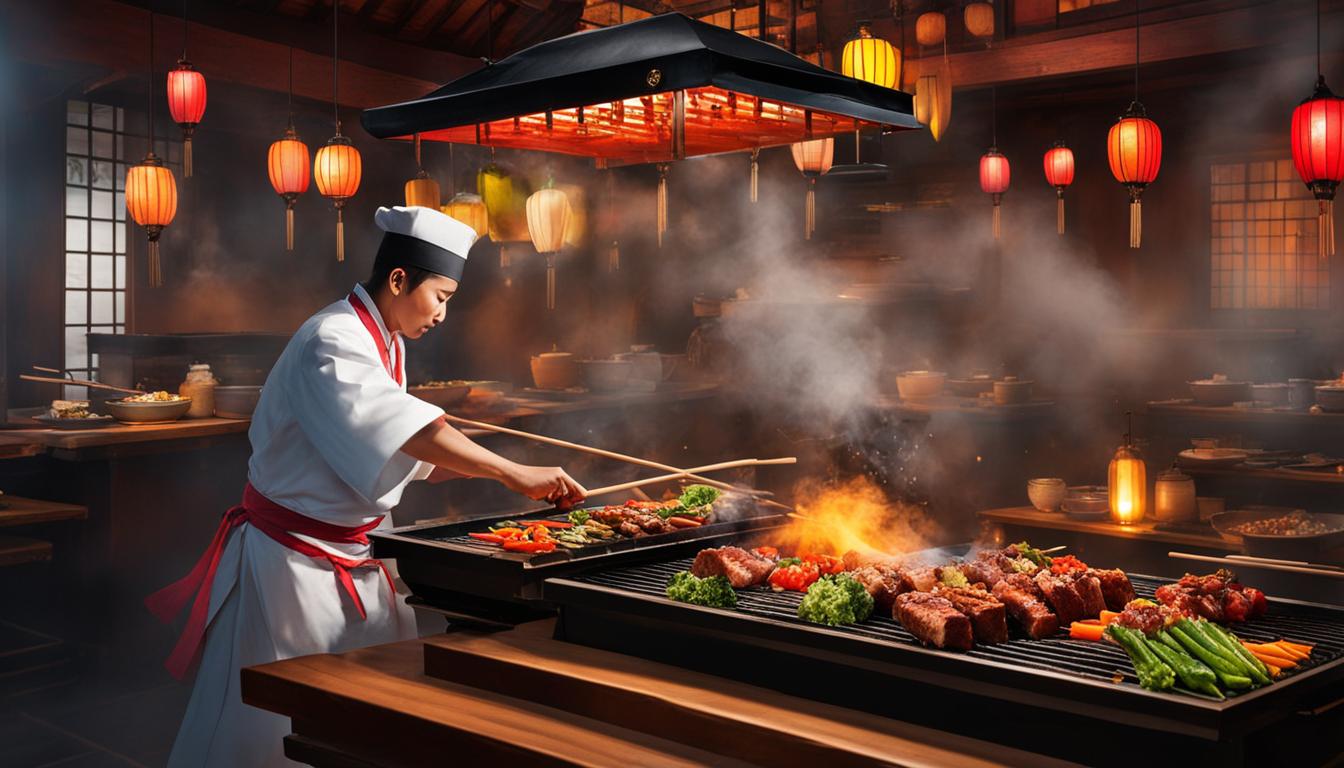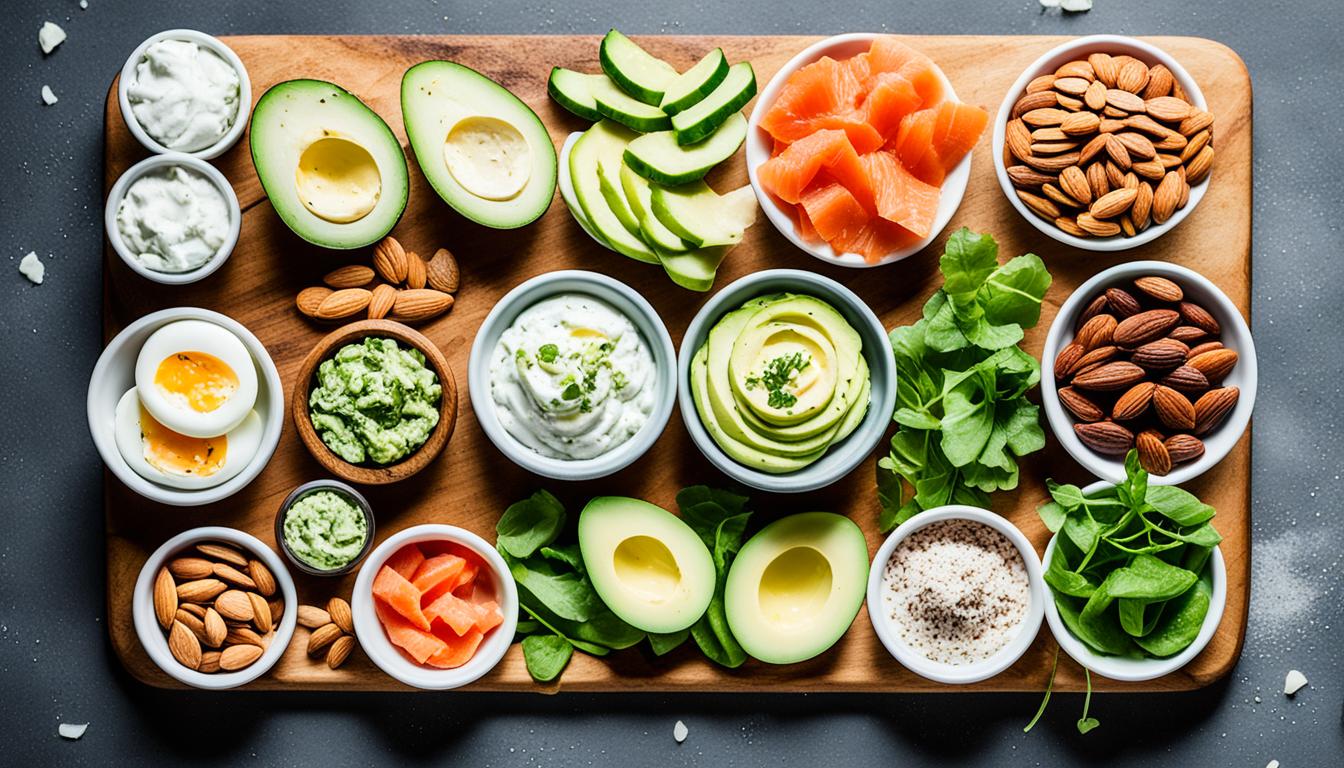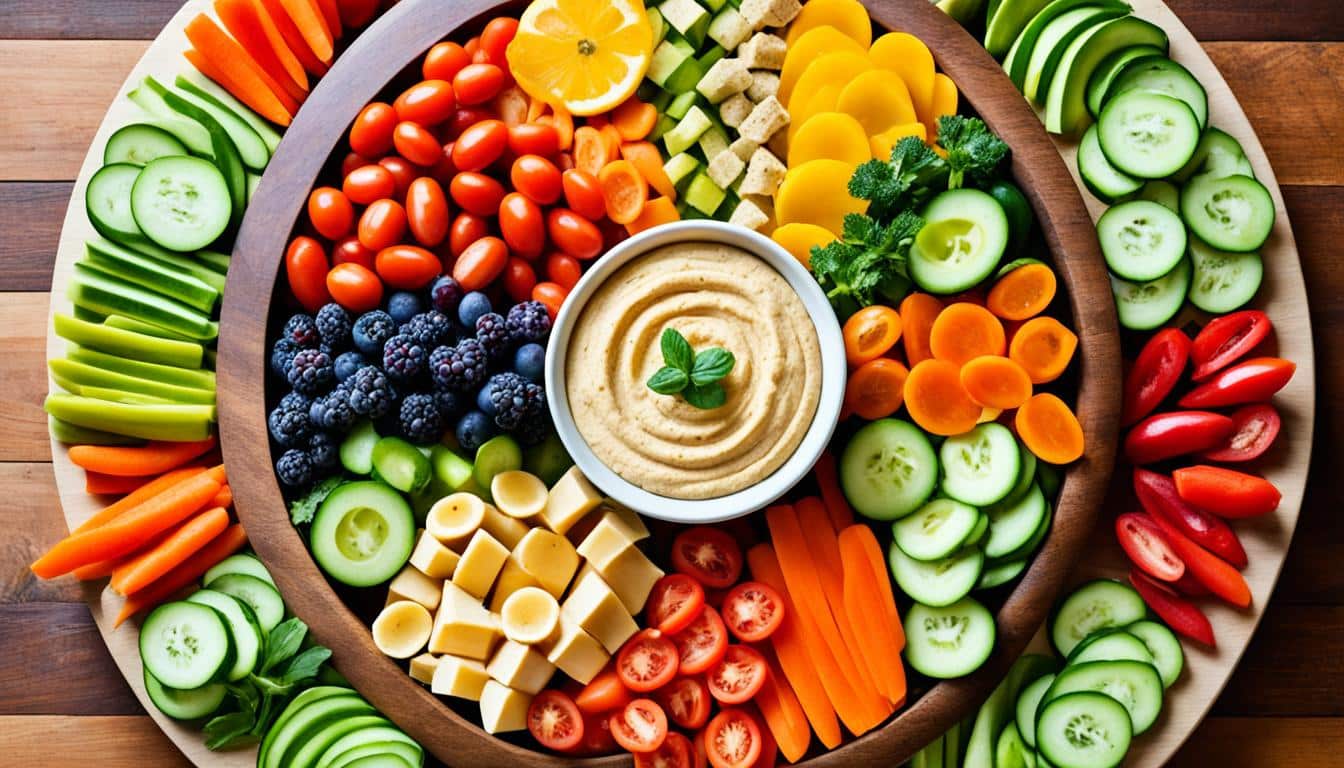What Is Hibachi Food : Hibachi food is a distinctive aspect of Japanese cuisine that combines delectable meals with creative culinary techniques. It is cooked using a hibachi grill, a traditional Japanese cooking apparatus. In this article, we will delve into the history and origins of Japanese hibachi cuisine, popular hibachi recipes, and why it has become a beloved dining experience.
Key Takeaways:
- Hibachi food is a unique aspect of Japanese cuisine.
- It is cooked using a hibachi grill.
- Japanese hibachi cuisine offers a delightful dining experience.
- Popular hibachi recipes include hibachi chicken, shrimp, steak, and vegetables.
- Hibachi food can be both flavorful and healthy.
What is Hibachi?
Hibachi is a Japanese word that refers to a large open bowl or tray, made of metal, wood, or ceramic material. Originally used as a heating appliance, it later evolved into a cooking apparatus. Hibachi chefs use this device to grill, sauté, stir-fry, and smoke Japanese recipes, creating flavorful and delicious dishes. The hibachi runs on gas or charcoal flames, with a special type of charcoal called “binchotan” being commonly used to achieve high temperatures.
The hibachi grill is a versatile cooking tool that allows for precise control over the heat. The high temperatures provided by the grill help to sear the food quickly, locking in the natural juices and flavors. Whether it’s grilling succulent meats, stir-frying fresh vegetables, or creating a smoky aroma, the hibachi offers a unique cooking experience that adds depth and complexity to Japanese cuisine.
The use of binchotan charcoal in hibachi grilling is another factor that sets it apart. Binchotan is a type of charcoal made from oak or chestnut wood and is known for its high carbon content and long burning time. It produces minimal smoke and imparts a distinct flavor to the food, enhancing the overall taste and aroma. The combination of the hibachi grill and binchotan charcoal results in a culinary experience that is both visually appealing and full of rich flavors.
The Advantages of Hibachi Grilling
Hibachi grilling offers several advantages that make it a popular cooking method. Here are some key benefits:
- Quick Cooking: The high heat of the hibachi grill allows for fast and efficient cooking, making it perfect for busy households or restaurants with high customer turnover.
- Even Heat Distribution: The design of the hibachi grill ensures that the heat is evenly distributed, resulting in consistent cooking and perfectly cooked food.
- Intense Flavor: The searing heat of the hibachi grill creates a flavorful crust on meats and vegetables, adding depth and complexity to the final dish.
- Versatile Cooking: Hibachi grilling allows for a wide range of cooking techniques, from grilling and searing to stir-frying and smoking, making it a versatile tool in the kitchen.
Overall, hibachi cooking is a unique and exciting way to prepare food. Its combination of high heat, precise control, and distinct flavor profile makes hibachi a beloved cooking method in Japanese cuisine.
Sources
- “Hibachi – Japan Guide”
- “What Is Hibachi?” – The Spruce Eats
What is Japanese Hibachi Food?
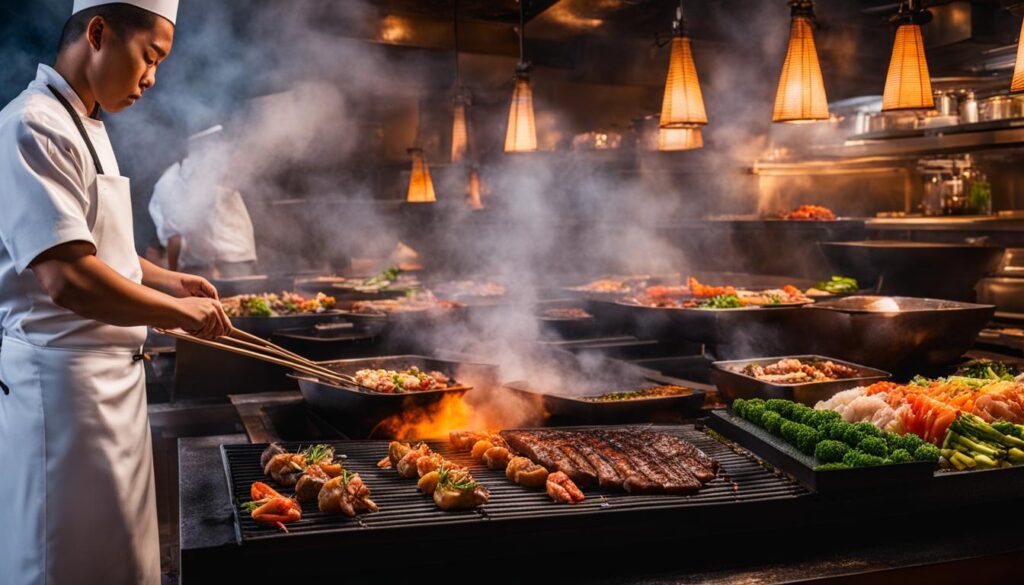
Japanese hibachi food is an exquisite culinary experience that showcases the artistry and skill of hibachi chefs. Using a hibachi grill, these talented chefs create mouthwatering dishes with a combination of fresh meats, vegetables, and a high searing temperature. The result is a delectable feast that delights the senses and leaves diners craving for more.
The secret to Japanese hibachi food lies in the preparation and cooking techniques employed by the hibachi chefs. They start with the finest quality ingredients, ensuring that the meat is tender and the vegetables are crisp and flavorful. With precision and finesse, the chefs sear the ingredients on the hibachi grill, where the high heat quickly locks in the natural juices and imparts a rich, smoky flavor.
The beauty of Japanese hibachi food lies in its simplicity and focus on the natural flavors of the ingredients. The chefs often use minimal condiments and spices, allowing the freshness of the meat and vegetables to shine through. Whether it’s succulent steak, juicy shrimp, or perfectly grilled vegetables, each bite is a burst of flavor and texture that tantalizes the taste buds.
Japanese hibachi food is not only a culinary delight but also a visual spectacle. The skilled hibachi chefs entertain and engage diners with their impressive cooking techniques, such as flipping utensils and creating impressive fiery displays. The combination of delicious food and captivating performance makes dining at a hibachi restaurant an unforgettable experience.
Hibachi Food: A Gastronomic Adventure
When it comes to Japanese hibachi food, it’s not just about the delicious flavors and stunning presentations. It’s a gastronomic adventure that transports diners to a culinary paradise where they can savor the artistry, skill, and passion of hibachi chefs. Whether you’re a fan of meat, seafood, or vegetarian delights, Japanese hibachi food offers a diverse range of options to suit every palate.
From tender hibachi steak cooked to perfection, to succulent shrimp that melts in your mouth, and vibrant vegetables bursting with freshness, each dish is a testament to the mastery of the hibachi chefs. It’s a culinary journey that combines the best of Japanese cuisine with the excitement of the hibachi cooking method.
So, the next time you’re looking for a dining experience that is both delicious and entertaining, head to a hibachi restaurant and indulge in the flavors of Japanese hibachi food. It’s an experience that will leave you craving for more and eagerly anticipating your next hibachi adventure.
Popular Hibachi Recipes
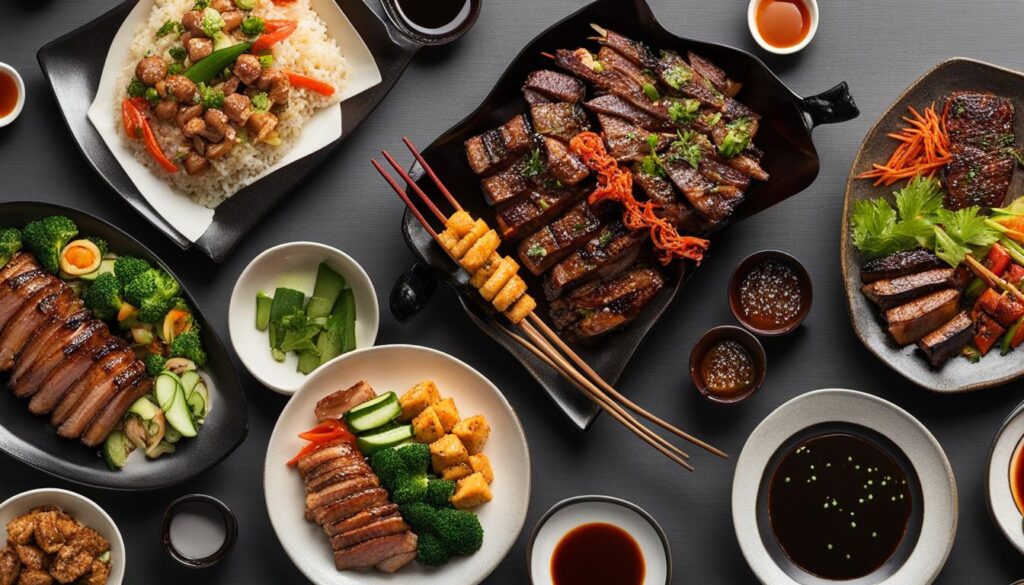
Hibachi cuisine offers a wide range of delicious and flavorful recipes that are enjoyed by many. From succulent hibachi chicken to mouth-watering hibachi shrimp and perfectly grilled hibachi steak, there is something for everyone to enjoy. Let’s explore some popular hibachi recipes that are sure to tantalize your taste buds.
Hibachi Chicken
Hibachi chicken is a classic hibachi dish that features tenderized chicken cooked to perfection on the hibachi grill. The chicken is seared with butter, which adds a rich and savory flavor, and then topped with a spicy teriyaki sauce for an extra kick. The combination of juicy chicken and the bold flavors of the teriyaki sauce make this dish a favorite among hibachi enthusiasts.
Hibachi Shrimp
For seafood lovers, hibachi shrimp is a must-try recipe. The shrimp can be grilled or stir-fried on the hibachi grill and is typically served with a delectable sweet and tangy Japanese shrimp sauce. The shrimp is cooked to perfection, resulting in a tender and succulent texture that pairs perfectly with the flavorful sauce. Hibachi shrimp is a crowd-pleaser that never fails to impress.
Hibachi Steak
If you’re a fan of steak, hibachi steak is the ultimate indulgence. Thick cuts of beef or lamb are seared and grilled on the hibachi, resulting in a tender and juicy steak with a smoky flavor. The steak can be topped with an umami gloss and mushroom sauce, adding extra depth and richness to the dish. Hibachi steak is a true delight for meat lovers and is often the star of the hibachi dining experience.
Hibachi Vegetables
For those seeking a vegetarian option, hibachi vegetables are a fantastic choice. The hibachi grill works its magic on a variety of succulent and seasoned veggies, enhancing their natural flavors and creating a delightful medley of textures. From crunchy bell peppers and zucchini to tender mushrooms and onions, hibachi vegetables offer a refreshing and vibrant addition to any hibachi meal.
| Recipe | Ingredients | Instructions |
|---|---|---|
| Hibachi Chicken | Chicken breast, butter, teriyaki sauce, salt, pepper | Tenderize the chicken and season with salt and pepper. Sear the chicken with butter on the hibachi grill. Top with spicy teriyaki sauce. |
| Hibachi Shrimp | Shrimp, Japanese shrimp sauce, salt, pepper | Grill or stir-fry the shrimp on the hibachi grill. Serve with sweet and tangy Japanese shrimp sauce. |
| Hibachi Steak | Beef or lamb steak, umami gloss, mushroom sauce, salt, pepper | Season the steak with salt and pepper. Sear and grill the steak on the hibachi grill. Top with umami gloss and mushroom sauce. |
| Hibachi Vegetables | Assorted vegetables (bell peppers, zucchini, mushrooms, onions), salt, pepper | Grill the vegetables on the hibachi grill until tender and lightly charred. Season with salt and pepper. |
Why Does Everyone Love Hibachi Food?
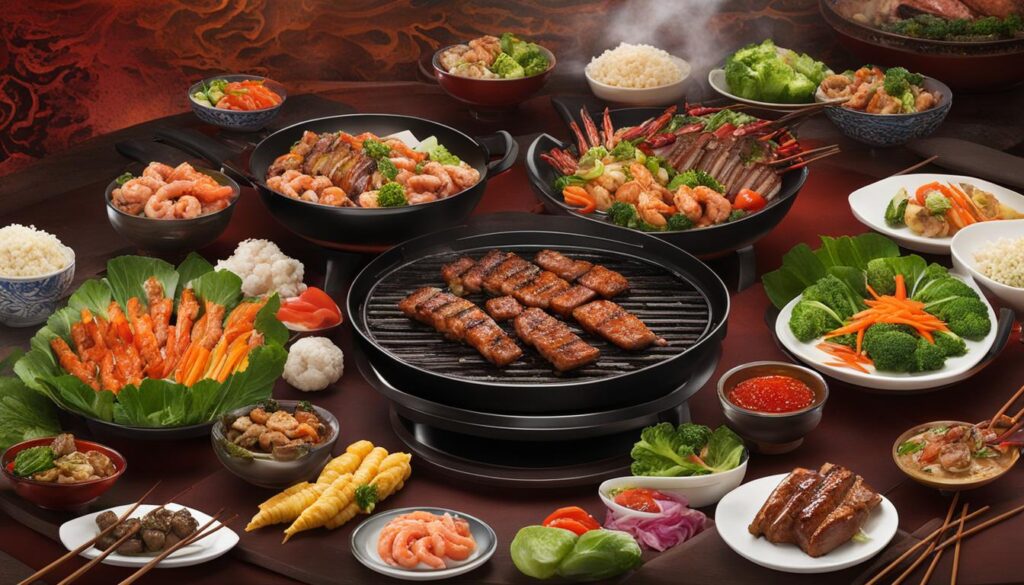
Hibachi cuisine offers a sensory delight that captivates all the senses. From the searing sounds of the sizzling grill to the mouth-watering flavors that dance on your taste buds, every aspect of hibachi food creates a truly delectable dining experience. But it’s not just the taste that makes hibachi so beloved—it’s also the visual presentation that adds to its appeal.
When you sit at a hibachi table, you’re treated to a spectacle of culinary artistry. Hibachi chefs showcase their skills with impressive techniques, like flipping and juggling utensils, as they cook your meal right in front of you. The soaring flames, the expert precision, and the elegant movements all contribute to an engaging and memorable dining experience.
But it’s not just the showmanship that draws people to hibachi. The food itself is a delight. Hibachi cuisine combines fresh ingredients with the high searing temperature of the grill, resulting in dishes that are tender, flavorful, and cooked to perfection. Whether you’re savoring a juicy steak, succulent shrimp, or a medley of grilled vegetables, each bite is a sensational burst of flavor that keeps you coming back for more.
Quotes:
“The sizzling sounds and enticing aromas of hibachi food create a sensory experience that is hard to resist.” – Hibachi enthusiast
“The visual presentation of hibachi cooking is like watching an artist at work. It adds an extra layer of enjoyment to the meal.” – Food critic
Benefits of Hibachi Cuisine:
- Searing sounds and sizzling aromas create a sensory delight
- Mouth-watering flavors that satisfy the taste buds
- Visual presentation adds to the overall dining experience
- Fresh ingredients cooked to perfection
- Showmanship and culinary artistry of hibachi chefs
Is Hibachi Food Healthy?
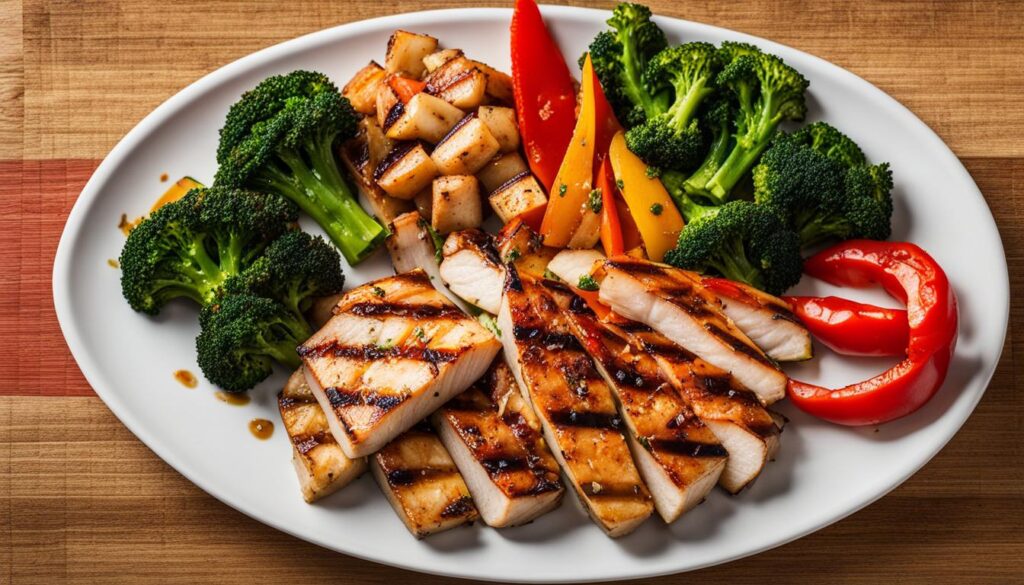
When it comes to the healthiness of hibachi food, it ultimately depends on the recipe and cooking techniques used. Unlike deep-fried dishes, hibachi food is typically grilled or sautéed, which can help limit the amount of added fat. The high temperature of the hibachi grill allows for quick cooking, which helps retain the natural flavors and nutrients of the ingredients.
One way to ensure a healthy hibachi meal is to choose lean proteins such as chicken or seafood and opt for a variety of colorful vegetables. By incorporating a good balance of protein and fiber-rich vegetables, you can create a nutritious and well-rounded meal. It’s also important to control portion sizes and limit the use of sauces and seasonings high in salt and sugars.
Overall, hibachi food can be a healthy dining option when prepared with fresh and wholesome ingredients, cooked using minimal added fats, and balanced with a variety of nutrient-dense foods. By making mindful choices and staying conscious of your portion sizes, you can enjoy the flavors and experience of hibachi cuisine while maintaining a balanced and nutritious diet.
Benefits of Hibachi Cooking Techniques
Hibachi cooking techniques offer several benefits that contribute to the overall healthiness of the food. The high heat used in hibachi grilling results in quick cooking, which helps to preserve the nutritional value of the ingredients. Additionally, grilling or sautéing the food allows it to retain more of its natural flavors, eliminating the need for excessive seasonings or sauces.
- Quick cooking helps retain nutrients
- Preserves natural flavors without excessive seasonings
- Grilling or sautéing limits added fats
- Enhances variety by incorporating fresh vegetables and lean proteins
Nutritional Balance in Hibachi Food
When enjoying hibachi food, it’s important to maintain a balanced and nutritious meal. Aim to include a variety of food groups, such as whole grains, lean proteins, and plenty of fruits and vegetables. This will provide the necessary nutrients, vitamins, and minerals your body needs for optimal health.
| Protein | Choose lean meats like chicken or seafood. These options are lower in fat and can provide essential amino acids. |
|---|---|
| Vegetables | Incorporate a colorful array of vegetables to ensure a diverse nutrient profile. Opt for steamed or grilled vegetables to retain their nutritional value. |
| Carbohydrates | Include whole grains like brown rice or quinoa for sustained energy. These options provide fiber and essential nutrients. |
| Fats | Choose healthy fats like avocado or olive oil in moderation. These fats can help promote heart health when consumed in appropriate amounts. |
| Sauces and Seasonings | Opt for sauces and seasonings with lower sodium content to reduce excessive salt intake. Use them sparingly to enhance flavors without overpowering the dish. |
By following these guidelines and making mindful choices, you can enjoy a healthy and satisfying hibachi meal that nourishes your body while indulging in the unique flavors and culinary experience that hibachi cuisine offers.
How to Eat Healthy at a Hibachi Restaurant?
To enjoy a healthy meal at a hibachi restaurant, there are a few tips and choices that you can make. By opting for nutritious options and mindful eating, you can still savor the flavors of hibachi cuisine while making health-conscious choices.
1. Hydrate with Water
Start your meal with a refreshing glass of water. Not only will it cleanse your palate, but it will also help reduce acidity and keep you hydrated throughout your dining experience. Drinking water before a meal can also help you eat smaller portions and promote healthy digestion.
2. Begin with a Salad
Choose a salad as your appetizer to incorporate fresh vegetables into your meal. Salads are usually low in calories and packed with fiber, vitamins, and minerals. Opt for a salad with a variety of colorful vegetables, such as lettuce, cucumbers, carrots, and tomatoes. You can also add some lean protein, like grilled chicken or tofu, for an extra boost of nutrition.
3. Enjoy Miso Soup
Miso soup is a classic Japanese dish that is both nutritious and comforting. It is made from fermented soybean paste and often includes additional ingredients like tofu, seaweed, and green onions. Miso soup is low in calories and high in antioxidants, vitamins, and minerals. Starting your meal with a bowl of miso soup can provide you with energy and help control your appetite.
4. Opt for a Small Dessert or Green Tea
Finish your meal on a satisfying note with a small dessert or a cup of green tea. If you have a sweet tooth, choose a small dessert that is not overly indulgent. Alternatively, you can opt for a cup of green tea, which is known for its numerous health benefits. Green tea is rich in antioxidants and can aid in digestion and promote relaxation.
By following these tips, you can enjoy a healthy meal at a hibachi restaurant without sacrificing flavor or the unique dining experience it offers. Remember to listen to your body’s hunger and fullness cues, and be mindful of portion sizes. Embrace the fresh ingredients and culinary techniques that hibachi cuisine has to offer while making choices that align with your health goals.
Hibachi vs Teppanyaki: What’s the Difference?
In the world of Japanese cuisine, hibachi and teppanyaki are two cooking styles that often get mistaken for one another. While both involve grilling food and have similar origins, they differ in terms of the heating devices used and the specific cooking techniques employed.
Hibachi cooking style: Hibachi refers to the method of grilling food on an open-top cooking surface using a hibachi grill. A hibachi grill is typically fueled by gas or charcoal flames, which provide the high heat necessary for searing and grilling. It is known for its ability to create delicious smoky flavors and impart a charred crust on the food.
Teppanyaki cooking style: Teppanyaki, on the other hand, involves cooking food on a large iron griddle. The griddle is heated by gas or electric elements, which evenly distribute heat and allow for precise control of temperature. Teppanyaki cooking is characterized by its theatricality, as chefs perform impressive tricks and showmanship while preparing the food right in front of diners.
Both hibachi and teppanyaki employ Japanese grilling techniques and offer unique flavors. However, the choice between the two comes down to personal preference for the cooking style, ambiance, and dining experience desired.
The History of Hibachi
The hibachi has a fascinating history that traces its origins back to ancient Japan. Originally used as a heating device, the hibachi gradually evolved into a versatile cooking apparatus that has become synonymous with Japanese cuisine. In its early days, people would use the hibachi to warm their homes during the chilly winters. However, they soon discovered that it could be used for more than just heating.
As time passed, the hibachi transformed into a mini barbecue, with individuals grilling small items like fish and vegetables on its open-top cooking surface. The word “hibachi” itself refers to a large open bowl or tray that was traditionally made of metal, wood, or ceramic material. It was the perfect tool for those who wanted a simple and efficient way to cook their food.
Today, hibachi-style cooking has gained widespread popularity and can be found in Japanese restaurants all over the world. The hibachi grill, fueled by gas or charcoal flames, is used by skilled chefs to create a variety of mouthwatering dishes. Its unique combination of heating and cooking capabilities has made it an indispensable tool in the world of Japanese cuisine.
| Year | Event |
|---|---|
| Heian period (794-1185) | Hibachi used as a heating device |
| Post-Heian period | Hibachi starts being used for cooking |
| 1960s | Hibachi-style cooking gains popularity |
Table: The Evolution of Hibachi
What Makes Hibachi Food So Good?
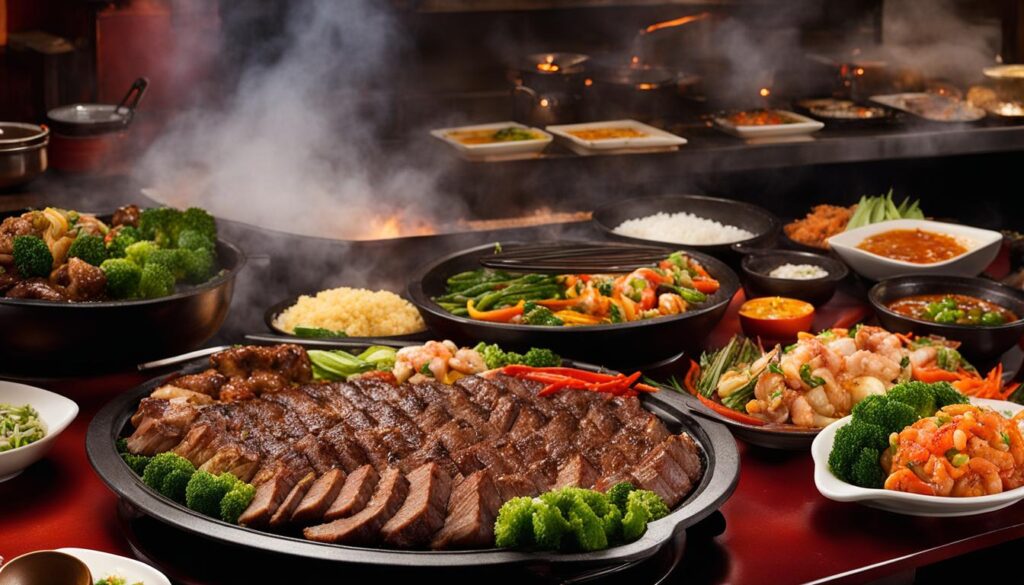
The popularity of hibachi food can be attributed to several factors that contribute to its unique appeal. From the tantalizing flavors to the interactive entertainment, hibachi dining offers a memorable experience that keeps people coming back for more.
Flavorful Delights
One of the main reasons why hibachi food is so beloved is its incredible flavor. The high heat of the hibachi grill seals in the juices and imparts a delicious smoky char to the meat and vegetables. This intense heat also allows for quick cooking, preserving the natural flavors and textures of the ingredients. Whether it’s perfectly seared steak, succulent shrimp, or perfectly seasoned vegetables, the flavors that come from the hibachi grill are truly mouthwatering.
Entertainment and Socializing
Another aspect that sets hibachi food apart is the interactive entertainment provided by the skilled hibachi chefs. These talented individuals not only cook the food right in front of you but also engage in impressive culinary performances, showcasing their knife skills, tossing ingredients in the air, and creating stunning fiery displays. This combination of cooking and entertainment creates a lively atmosphere and encourages social interaction among diners, making hibachi dining an enjoyable and memorable experience.
Customization and Freshness
Customization is another key element of hibachi food that appeals to many people. At hibachi restaurants, diners have the opportunity to choose their preferred proteins, vegetables, and seasonings, allowing for a personalized and tailored dining experience. This level of customization ensures that each meal is made to order and meets individual preferences. Additionally, the use of fresh ingredients adds to the overall appeal of hibachi food, ensuring that each dish is bursting with vibrant flavors and nutrients.
How is Hibachi Cooked?
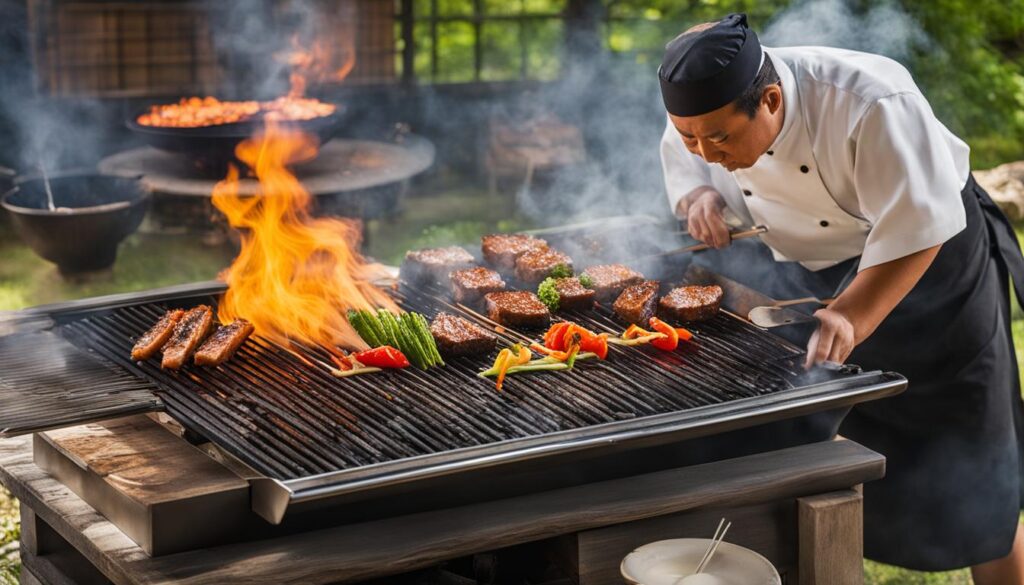
Hibachi cooking is a technique that relies on high heat and quick cooking methods to create flavorful and tender dishes. The key element of hibachi cooking is the hibachi grill, which is used to cook a variety of ingredients ranging from meats to vegetables.
The hibachi grill is heated to a high temperature, typically using either gas or charcoal flames. This intense heat allows for rapid cooking, sealing in the flavors and creating a delicious caramelization on the surface of the food.
When cooking hibachi steak, for example, the steak is seasoned with salt and pepper to enhance its natural flavors. It is then placed on the preheated hibachi grill, where it is cooked for a few minutes on each side. This cooking time can be adjusted based on the desired level of doneness for the steak. The result is a succulent and juicy steak that is cooked to perfection.
| Ingredients | Cooking Technique |
|---|---|
| Steak | Season with salt and pepper, grill on high heat for a few minutes per side |
| Chicken | Marinate in a flavorful sauce, grill on high heat until cooked through |
| Shrimp | Season with spices, grill or stir-fry until pink and opaque |
| Vegetables | Toss with oil and seasonings, grill until tender-crisp |
Hibachi cooking allows for the customization of flavors and ingredients, making it a versatile and enjoyable way to prepare meals. Whether you’re grilling steak, chicken, shrimp, or vegetables, the high heat of the hibachi grill ensures that each ingredient is cooked to perfection, resulting in dishes that are bursting with flavor.
Hibachi Steak Recipe
- Ingredients:
- 1 pound of steak (such as ribeye or striploin)
- Salt and pepper, to taste
- Instructions:
- Preheat the hibachi grill to high heat.
- Season the steak with salt and pepper on both sides.
- Place the steak on the grill and cook for a few minutes on each side, depending on the desired level of doneness.
- Remove the steak from the grill and let it rest for a few minutes before slicing.
- Serve the hibachi steak with your favorite side dishes and enjoy!
“Hibachi cooking combines high heat and quick cooking methods to create delicious and flavorful dishes. The hibachi grill is the star of the show, providing intense heat that seals in the flavors and creates a beautiful caramelization on the food. Whether you’re grilling steak, chicken, shrimp, or vegetables, hibachi cooking is a versatile technique that allows for customization and results in mouthwatering meals.” – Chef Hiroshi
Conclusion
Japanese hibachi food offers a unique and enjoyable dining experience that showcases the best of Japanese cuisine. With its mouthwatering ingredients, skilled grilling techniques, and visually compelling presentation, hibachi food has become a beloved aspect of Japanese culinary culture.
Whether you are a food lover looking to explore new flavors or simply seeking a memorable dining experience, hibachi food is sure to leave a lasting impression. The focus on freshness, flavor, customization, and entertainment sets hibachi cuisine apart from other dining options.
From savoring the searing sounds and mouthwatering aromas to enjoying the visual spectacle of the hibachi grill, every aspect of the hibachi dining experience is designed to delight the senses. Japanese hibachi food offers a true feast for both the palate and the eyes.
So, the next time you’re in the mood for something special, consider indulging in the wonderful world of hibachi. Immerse yourself in the rich flavors, vibrant colors, and lively ambiance of hibachi cuisine, and discover why it has captured the hearts and taste buds of diners around the world.
Also Refer : Healthy Junk Food: A Guide To Healthier Snacking Options
FAQs
Q: What is hibachi food?
A: Hibachi food refers to the traditional Japanese food style of cooking that involves using a charcoal grill or flat iron griddle to grill meats, vegetables, sushi and other food items. It is commonly associated with teppanyaki restaurants and is known used to grill for its unique cooking techniques and presentation.
Q: How is hibachi food cooked?
A: Hibachi food is cooked using a hibachi grill, also known as teppan, where the chef grills the food items right in front of the diners. The chef uses style of Japanese charcoal and implements traditional Japanese heating techniques to prepare the food to perfection.
Q: What are the main ingredients used in hibachi food?
A: The main ingredients used in hibachi food typically include a variety of meats such as beef, chicken, seafood, and vegetables. Additionally, soy sauce, fried rice, and noodles are commonly incorporated into hibachi dishes to add flavor and diversity to the meal.
Q: What is the role of hibachi chefs in preparing hibachi food?
A: Hibachi chefs are skilled professionals who are trained in the art of Japanese grilling and cooking techniques. They are responsible for not only cooking the food on a hibachi grill but also for entertaining diners with their impressive culinary skills and showmanship.
Q: Where can I find the best hibachi food?
A: The best hibachi food can often be found at authentic Japanese teppanyaki restaurants or specialized hibachi steakhouses. These establishments are known for their traditional Japanese-style hibachi cooking and the use of high-quality ingredients.
Q: What is the difference between hibachi and teppanyaki?
A: While the terms hibachi and teppanyaki are often used interchangeably, hibachi typically refers to the Japanese charcoal grill itself, while teppanyaki encompasses the traditional Japanese teppanyaki cooking style, which involves grilling food on a flat iron griddle at individual tables in restaurants.
Q: What makes hibachi food a popular choice for diners?
A: Hibachi food is popular among diners due to its interactive nature, where they can witness the skilled hibachi chefs grilling and tossing the food right in front of them. The combination of delicious flavors, entertaining culinary displays, and the overall dining experience contributes to its appeal.
Q: What are some traditional Japanese techniques used in hibachi cooking?
A: Traditional Japanese hibachi cooking involves the use of shichirin, a type of Japanese charcoal grill, to heat and grill the food. It also involves precise grilling and flipping techniques, as well as the art of incorporating soy sauce and other seasonings to enhance the flavors of the dishes.
Q: Is hibachi food suitable for a balanced diet?
A: Hibachi food can be a part of a balanced diet as it often includes a variety of grilled meats and vegetables, along with options such as fried rice and noodles. When consumed in moderation and in combination with other nutritious foods, hibachi dishes can contribute to a balanced and diverse diet.
Q: What are some key characteristics of the best hibachi restaurants?
A: The best hibachi restaurants are known for their authentic Japanese charcoal grills, skilled hibachi chefs, high-quality ingredients, and a lively atmosphere. They offer a range of grilled meats and vegetables, hibachi fried rice, and other traditional hibachi dishes, providing diners with an unforgettable culinary experience.









